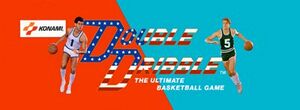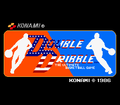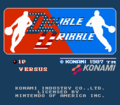m (fix bgcolor issue) |
(This code is fake. No one has ever gotten it to work and no one has ever seen the backboard shattering. There's not even a youtube or niconico video of it.) |
||
| Line 86: | Line 86: | ||
Few differences exist between the American and Japanese versions of the game. Apart from the change in media (from disk in Japan to cartridge in America), the Japanese version features driving back ground music during game play that is not present in the American version (where most of what you hear is the ball bouncing off the floor.) However, in the introduction of the American version, the national anthem is played, concluded with three balloons hoisting the American flag. In the Japanese version, only the sound of a cheering crowd is heard, and the last three balloons only contain streamers. | Few differences exist between the American and Japanese versions of the game. Apart from the change in media (from disk in Japan to cartridge in America), the Japanese version features driving back ground music during game play that is not present in the American version (where most of what you hear is the ball bouncing off the floor.) However, in the introduction of the American version, the national anthem is played, concluded with three balloons hoisting the American flag. In the Japanese version, only the sound of a cheering crowd is heard, and the last three balloons only contain streamers. | ||
{{-}} | {{-}} | ||
<gallery> | <gallery> | ||
Revision as of 01:37, 15 August 2011
Double Dribble was the second basketball arcade game developed and released in 1986 by Konami, following Super Basketball. The game features 5-on-5 action on a horizontally scrolling court. Much of the game's popularity came from its animation sequences showing basketball players performing slam dunks, as well as "The Star-Spangled Banner" theme during attract mode, which was the first arcade game to feature the national anthem. These were uncommon in video games at the time of Double Dribble's release. While successful in the arcades, the game became and remained popular and remembered when it was ported to the NES in 1987.
When brought home for the first time, Konami released the game on the Famicom Disk System in Japan under the name Exciting Basket (エキサイティング バスケット?), to make it part of Konami's Exciting Sports series. The game featured background music not present in the American release of the game, which was released on the NES in September of 1987. These home versions introduced four different teams (Boston Frogs, New York Eagles, Chicago Ox, L.A. Breakers), three levels of single-play difficulty, and four different choices of quarter lengths. Double Dribble was among the first games to feature cut scenes, which depicted a mid-air player completing a slam dunk, and one of the first to use computer generated speech, though in a limited quantity (such as announcing the game title, the game's beginning jump ball, and some foul calls).
In 1990, the game was ported to three home computers: the Commodore 64, the Commodore Amiga and MS-DOS operated PCs, and was based on the Famicom/NES versions more than the Arcade version. In 1991, a Game Boy version was released titled Double Dribble 5-on-5. A Sega Genesis version was released in 1994 titled Double Dribble: Playoff Edition (known as Hyperdunk in Japan and Europe). The NES version was ported to the Wii's Virtual Console in Europe and in North America on November of 2007. A remake titled Double Dribble Fast Break was released as an online exclusive, which is based mostly on the NES version; however, the animation sequences were ripped from the arcade version.
-
Arcade title screen.
Arcade
Controls
- Joystick: Use the joystick to control the player on your team who is currently in possession of the ball, or the player who is outlined in a blinking light while on defense. Every player can be directed to run in eight different directions on the court, including the four cardinal directions and the four diagonal direction.
- Dribble: In order to run with the ball, it is necessary to dribble. Tap the dribble button to ensure that the player with the ball keeps bouncing it off the floor. If the player ever stops dribbling, he must shoot or pass the ball. If you attempt to dribble the ball a second time, the referee will call you out for double dribbling.
- On defense, press the dribble button to attempt to steal the ball away from an opponent who has possession of the ball. If you are too aggressive, you may get called for a Pushing violation.
- Pass: Press this button to pass the ball from one player to another. The player you pass to will be determined by a combination of which players are closest to you and direction in which you hold the joystick. As long as the path is clear, your teammate will grab the ball, but if an opponent is in the way, they will steal it from you.
- On defense, press the pass button to change the currently selected defender to the teammate who is closest to the ball.
- Shoot: When you are ready to score points, press and hold the Shoot button down. Your player will leap up into the air. Release the Shoot button at the height of your jump to release the ball and send it to the hoop. If you shoot from inside the 3-point line while standing still, you will perform a simple 2 point throw. A shot thrown from outside the 3-point line is less likely to go in, but will be worth 3 points if it is successful. If you take a shot while running right up to the basket, it may be considered a slam dunk, in which case you will be shown one of five "zoomed in" slam dunk performances, before determining if your shot was successful. If you do not release the Shoot button by the time you land, you will be called for Traveling.
- On defense, press the shoot button to jump up in the air, in an attempt to block the shot being thrown by your opponent, or to catch the rebound before anyone else has a chance to. Timing is critical.
- Shooting from the free throw line initiates a moving circle to appear above the hoop. The closer the circle is to the hoop when you release the Shoot button, the more likely the ball is to go in.
- 1 - 2 players: Press either button to begin a one or two player game. See below for information about time and credits.
Game play
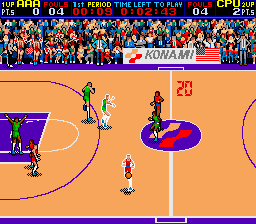
Credits purchased in the arcade version are used to buy time. After every minute of play, the player must insert another credit if they wished to continue when the score was tied or the computer is ahead. However, if the player is ahead, a "free" minute is earned. Many average players can earn the first free minute, but this becomes increasingly more difficult to do as making 3-point shots becomes virtually impossible over the course of gameplay.
Several positions on the court were 'hot spots,' high-percentage areas where shots-taken were likely to score points. For example: it is easier to hit a 3-pointer on the bottom right-hand side of the screen. A player could start a 3-point jump shot from the top right or left corner of the court inbound, and continue the jump out of bounds and even slightly behind the hoop and it would go in nearly every time. Another nearly guaranteed shot is taken with the player standing 3-quarters length of the court away from their goal could go for a running 3-point shot, provided that the shot button was pressed within the other team's free throw shooting circle.
Violations
Some violations result in throw-ins from the edge of the court, while personal fouls result in two free throws worth one point each.
- Double Dribbling: Dribbling the ball, than ceasing to dribble the ball, and then dribbling the ball once again instead of shooting or passing.
- Traveling: Pressing and holding Shoot to jump up and down with the ball without releasing Shoot to throw the ball to the hoop.
- Out of bounds: Throwing or passing the ball to some region outside of the court.
- 5 Second Violation: Failing to pass the ball in on a throw-in within 5 seconds.
- 10 Second Violation: Failing to leave your half of the court and enter the opponents half within 10 seconds of possession of the ball.
- 24 Second Violation: Failing to shoot the ball to the hoop within 24 seconds of possession of the ball.
- Backpass: Passing or even dribbling the ball back across the half-court line to your own half of the court after you first cross.
- Pushing: A personal foul where aggressively attempting to steal the ball causes you to push the opponent down.
- Blocking: A personal foul where you interfere with an opponent while they are attempting to shoot the ball.
Home conversions
Controls
 : Use the direction pad to control the player on your team who is currently in possession of the ball, or the player who is outlined in a blinking light while on defense. Every player can be directed to run in eight different directions on the court, including the four cardinal directions and the four diagonal direction.
: Use the direction pad to control the player on your team who is currently in possession of the ball, or the player who is outlined in a blinking light while on defense. Every player can be directed to run in eight different directions on the court, including the four cardinal directions and the four diagonal direction. : Press the A button to pass to a nearby teammate. Use the control pad to designate between more than one potential teammate. On defense, press the A button to attempt to steal the ball, or to jump up and block a shot when the opponent shoots.
: Press the A button to pass to a nearby teammate. Use the control pad to designate between more than one potential teammate. On defense, press the A button to attempt to steal the ball, or to jump up and block a shot when the opponent shoots. : Press and hold the B button to shoot the ball to the hoop. Release the B button at the height of your jump to release the ball. On defense, press the B button to switch the controlled defensive player to the teammate which is closest to the ball.
: Press and hold the B button to shoot the ball to the hoop. Release the B button at the height of your jump to release the ball. On defense, press the B button to switch the controlled defensive player to the teammate which is closest to the ball. : Press the Start button to begin a new game, or to pause the action mid-game.
: Press the Start button to begin a new game, or to pause the action mid-game. : Press the Select button to bypass the opening scene where the national anthem is played (in the American version. In the Japanese version, only the cheer of the crowd is heard.)
: Press the Select button to bypass the opening scene where the national anthem is played (in the American version. In the Japanese version, only the cheer of the crowd is heard.)
Getting Started
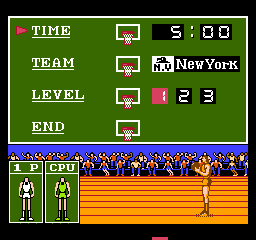
Before the game begins, you have control over several settings, including how many minutes each period lasts, what team you would like to use, and the level of difficulty.
- Time: You may choose between 5, 10, 20, and 30 minute periods. Each game contains 4 periods. So the total game will last four times as long as your choice.
- Team: There are four different teams to choose from. In a one player game, the computer will always select the Boston Frogs, so that selection will be unavailable to the player. The Boston Frogs can only be chosen in a two player game. See the team descriptions below.
- Level: Choose which level of difficulty to play at. At level 1, the opponent won't try to steal as much and may take longer to set up their shots, as you compete for a Bronze trophy. At level 2, the opponents get a little more aggressive and steal the ball away more frequently, in their quest to win the Silver trophy. At level 3, the ball will get stolen away from you at ever opportunity, and they opponent won't hesitate to drive the ball to the hoop as quickly as possible, while you compete for the number one position and the Gold trophy.
- In a two player game, you do not choose the level of difficulty. In its place, you will choose the second player's team, which does not necessarily have to be the Boston Frogs.
- End: Accept the current settings and begin your game.
| Team | 3 point shot | Close shot | Defense | Description |
|---|---|---|---|---|
| Boston Frogs | ♦♦♦♦ | ♦♦ | ♦♦♦ | This team is characterized by its jumping ability and intelligent offensive plays. Like a frog, the players have tremendous jumping abilities and rarely miss a rebound. |
| Chicago Ox | ♦♦♦ | ♦♦♦ | ♦♦ | This is a team with guts; they play aggressively and overpower their opponents. Just like an Ox, their aggressive play stands out whenever they drive the ball to the hoop. |
| L.A. Breakers | ♦♦ | ♦♦ | ♦♦♦♦ | This team overwhelms the opponent like a giant wave. They are impressive because of their team play. And like a wave, once they gain momentum, they overpower any team in their way. |
| N.Y. Eagles | ♦ | ♦♦♦♦ | ♦♦♦ | This is characterized by quick moves and accurate shooting. Like their mascot, the eagle, they play by cutting through the opponent's defense to create shooting opportunities. |
Game play
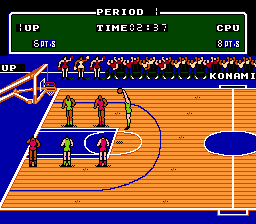
Gameplay in the home conversions is nearly identical to the arcade version except for the obvious omission of the dribble button. Dribbling occurs automatically, and does not stop until the ball is passed or shot. Thus it is impossible to get a double dribble violation, despite the irony of the game's title. All the other violations are still possible. While the arcade has five different slam dunk "movies", the home versions only have three: the Dunk Shot, the Back Dunk Shot, and the One-Hand Dunk Shot.
Defense is considerably more difficult than offense, so it is important to build up your shooting skills to keep the score high, and take away a few opportunities from the computer to succeed. Good use of passing is a must at higher levels to avoid having the ball stolen from you. Worry less about getting dramatic 3 pointers or being presented with a dunk movie, and focus on solid scoring opportunities. At the same time, it's a good idea to know where the 3-pointer sweet spots are on the court in case you need to close the gap in score between you and your opponent.
Few differences exist between the American and Japanese versions of the game. Apart from the change in media (from disk in Japan to cartridge in America), the Japanese version features driving back ground music during game play that is not present in the American version (where most of what you hear is the ball bouncing off the floor.) However, in the introduction of the American version, the national anthem is played, concluded with three balloons hoisting the American flag. In the Japanese version, only the sound of a cheering crowd is heard, and the last three balloons only contain streamers.
-
Japanese promotional flyer
-
Famicom Disk System cover
-
Famicom Disk System title
-
Computer box
-
NES box
-
NES title screen
